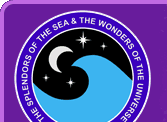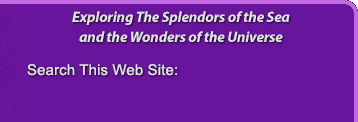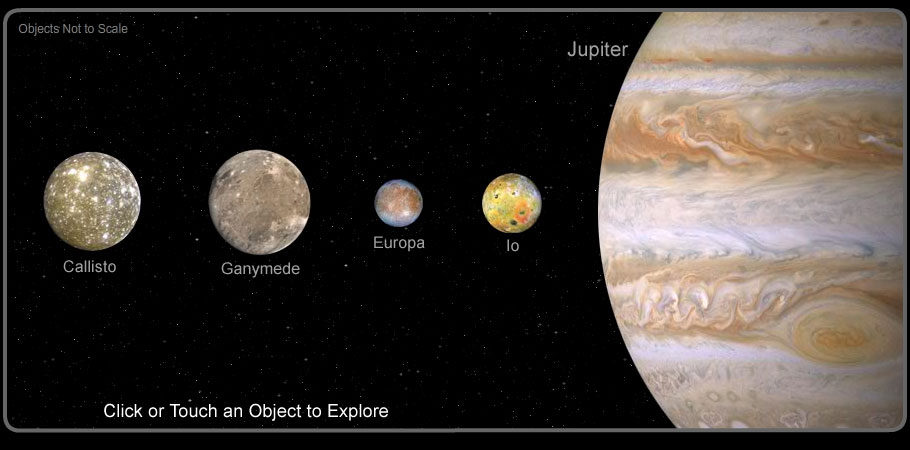The Giant
As we emerge from the scattered fragments of the asteroid belt, we are presented with a truly awesome sight. We have left behind the rocky worlds of the inner planets and have now entered the realm of the gas giants. Here we encounter the fifth planet from the Sun. At over a thousand time the size of Earth, it is also the largest planet in the Solar System. Brilliant colors of red, brown, and orange form bands and swirls in its gaseous atmosphere. A faint ring of delicate, icy material encircles the planet, and many natural satellites of varying sizes can be found in orbit. This is the planet Jupiter and its complex system of moons.
A Solar System in Miniature
Recent discoveries in the Jovian system have now brought the total number of known moons to 63. Four of these moons are nearly planet-sized. Known collectively as the Galilean satellites, they were first discovered by Galileo Galilei when he turned his small telescope toward the giant planet. These four moons can also be seen with a good pair of binoculars, and will appear as four tiny dots on either side of the brighter planet.
Jupiter's other moons are much smaller, and most are probably asteroids that were captured by the giant planet's strong gravitational field. With so many natural satellites, the Jovian system nearly represents a miniature solar system. In fact, many astronomers believe that if Jupiter had been about 80 times more massive, it would have become a second star in orbit around the Sun. If this had happened, the large Galilean moons orbiting Jupiter would probably have been classified as planets.
A Dynamic System
Because of Jupiter's massive size, it has an enormous impact on the objects around it. One of the most dramatic examples can be found on its moon Io. Because Io orbits so close to its parent planet, the gravitational tidal forces actually cause the moon to stretch. This creates a great deal of friction within the small moon, which generates a great deal of heat. This is the power source behind the active volcanoes that have been discovered on Io's surface.
Jupiter's gravity also had a strong impact on its other moons. On Europa, the gravitational forces crack and shift its icy crust. It most likely has a heating effect on the moon's core. Because of this, most astronomers believe that an ocean of liquid water may exist beneath Europa's frozen crust. A source of heat could provide the right conditions for life, similar to the communities of organisms found around the deep sea hydrothermal vents in the oceans on Earth.
Exploring the Jovian System
To date, the Jovian system has been visited by a total of eight spacecraft. Pioneer 10 was the first to explore this previously uncharted territory in 1973. It was followed by Pioneer 11 about a year later. These spacecraft provided us with our first close-up views of the planet and discovered its magnetic field and radiation belts. They gathered valuable information about some of the moons and paved the way for future missions.
In 1979, the first of two new spacecraft encountered the Jovian system. Voyager 1 made it closest approach to the system in March, followed soon by Voyager 2 in July. These two spacecraft sent back amazing new images of Jupiter and its moons. Many new moons were discovered, and the four Galilean moons were discovered to be much more dynamic and unique than previously thought. Evidence of of volcanic eruptions was discovered on Io, and features on Europa hinted at a possible ocean of water beneath the ice.
Two other spacecraft flew past the Jovian system for a gravity boost on their way to other destinations. The Ulysses probe shot past Jupiter in 1992 on its way to study the Sun. NASA's New Horizons probe encountered the Jovian system in 2007 on its way to study Pluto and the Kuiper belt. These two spacecraft sent back new images and new information that helped better our understanding of Jupiter and its moons.
The biggest contribution to our understanding of the Jovian system has come from the Galileo mission. On December 7, 1995, it became the first spacecraft to go into orbit around Jupiter. On that same day, a special probe released from Galileo entered Jupiter's atmosphere and send back valuable information about its chemistry. Galileo sent back hundreds of high resolution images of Jupiter and many of its moons. A technical problem with the high gain antenna prevented it from sending more, but what we did get was a treasure trove of new information and new views of the Jovian system.
NASA is planning a new mission to study Jupiter in even more detail. Known as Juno, the spacecraft is scheduled to be launched in August 2011. It will enter a polar orbit around Jupiter where it will study the planet's composition, magnetic field, and other aspects to try to determine how it was formed and exactly what it is made of.




